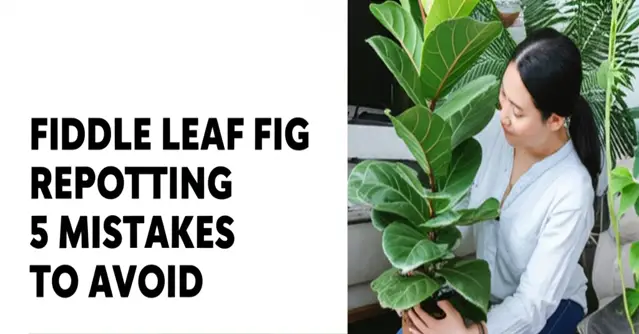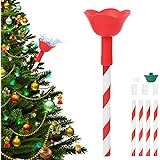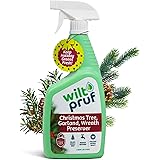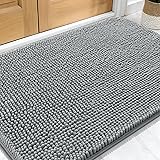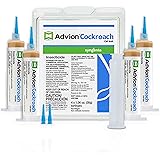Ah, the Fiddle Leaf Fig (Ficus lyrata). Its large, violin-shaped leaves and elegant stature make it a coveted houseplant. But owning one comes with its challenges, and repotting can feel like a daunting task. Fear not! This comprehensive guide will walk you through the repotting process, highlighting the 5 most common mistakes to avoid and providing pro tips to ensure your Fiddle Leaf Fig thrives in its new home.
We’ll cover everything from when to repot to the best soil mix, ensuring you’re equipped with the latest information and techniques for success. Let’s get started and turn that repotting anxiety into a repotting triumph!
Why Repotting Matters for Your Fiddle Leaf Fig
Repotting is more than just moving your plant to a bigger container. It’s a vital part of maintaining its health and encouraging growth. Here’s why:
- Provides Fresh Nutrients: Over time, the soil in your Fiddle Leaf Fig’s pot becomes depleted of essential nutrients. Repotting with fresh soil replenishes these nutrients, giving your plant the fuel it needs to grow.
- Improves Drainage: Soil can become compacted over time, hindering drainage and leading to root rot. Repotting with well-draining soil prevents waterlogging and promotes healthy root growth.
- Allows for Root Growth: As your Fiddle Leaf Fig grows, its roots will eventually fill the entire pot. Repotting into a larger container gives the roots more room to expand, allowing the plant to absorb more water and nutrients.
- Addresses Rootbound Conditions: A rootbound plant is one where the roots have circled the inside of the pot, restricting growth and nutrient uptake. Repotting helps to alleviate this issue and gives the roots room to spread out.
- Prevents Soilborne Diseases: Old soil can harbor harmful bacteria and fungi that can lead to plant diseases. Repotting with fresh, sterile soil helps to prevent these issues.
According to a 2023 study by the University of California, Riverside, repotting houseplants every 1-2 years can significantly improve their overall health and growth rate, particularly for fast-growing species like the Fiddle Leaf Fig.
When to Repot Your Fiddle Leaf Fig: Recognizing the Signs
Knowing when to repot is crucial. Don’t just repot because you feel like it! Here are some telltale signs your Fiddle Leaf Fig is ready for a new home:
- Roots Emerging from Drainage Holes: This is a clear sign that the roots have outgrown the pot and are searching for more space.
- Slowed Growth: If your Fiddle Leaf Fig’s growth has stalled, even during the growing season (spring and summer), it could be rootbound.
- Frequent Watering: If the soil dries out very quickly after watering, it could indicate that the roots have filled the pot, leaving little room for soil to retain moisture.
- Yellowing Leaves: While yellowing leaves can indicate several problems, including overwatering or underwatering, it can also be a sign of nutrient deficiency due to rootbound conditions.
- Plant is Top-Heavy: If your Fiddle Leaf Fig is tipping over easily, it might be because the roots are no longer providing adequate support.
- Soil Compaction: If the soil is hard and compacted, even after watering, it’s time to repot.
Best Time to Repot: Ideally, repot your Fiddle Leaf Fig during the spring or early summer, which is its active growing season. This gives the plant ample time to recover and establish new roots before the dormant period in the fall and winter.
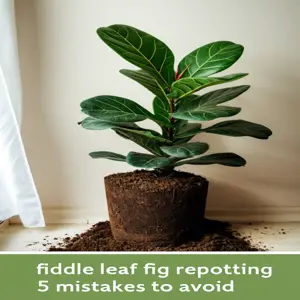
repotting fiddle leaf fig
The 5 Biggest Fiddle Leaf Fig Repotting Mistakes (and How to Avoid Them!)
Let’s dive into the common pitfalls that can plague Fiddle Leaf Fig repotting and how to sidestep them successfully.
Mistake #1: Choosing the Wrong Pot Size
This is arguably the most common mistake. Many plant owners assume that bigger is always better when it comes to pot size. However, repotting into a pot that’s too large can be detrimental to your Fiddle Leaf Fig’s health.
Why a Pot That’s Too Big is Bad
- Overwatering: A large pot holds more soil, which means it retains more water. This can lead to overwatering and root rot, a common killer of Fiddle Leaf Figs. The excess soil stays wet for longer periods, creating a breeding ground for anaerobic bacteria.
- Nutrient Imbalance: In a pot that’s too large, the roots may not be able to reach all the soil, leading to uneven nutrient distribution. The plant will struggle to absorb nutrients effectively, resulting in stunted growth or yellowing leaves.
- Slow Root Development: The plant will focus its energy on filling the pot with roots instead of producing new leaves. This can significantly slow down the plant’s overall growth.
How to Choose the Right Pot Size
The general rule of thumb is to increase the pot size by only 1-2 inches in diameter. For example, if your Fiddle Leaf Fig is currently in a 10-inch pot, repot it into a 12-inch pot. Here’s a breakdown:
| Current Pot Size (inches) | Recommended New Pot Size (inches) |
|---|---|
| 6 | 7-8 |
| 8 | 9-10 |
| 10 | 11-12 |
| 12 | 13-14 |
Pro Tip: Consider the overall size and maturity of your Fiddle Leaf Fig. A very young plant might only need a slight increase in pot size, while a more mature plant might benefit from a slightly larger upgrade within the 1-2 inch guideline.
Pot Material Matters
The material of the pot also plays a role in drainage and moisture retention. Terracotta pots are porous and allow for better airflow, reducing the risk of overwatering. Plastic pots, on the other hand, retain more moisture. Consider your watering habits and the environment your Fiddle Leaf Fig lives in when choosing a pot material.
Real-World Example: Sarah, a new Fiddle Leaf Fig owner, repotted her plant from an 8-inch pot directly into a 14-inch pot. Within weeks, the plant developed root rot and started dropping leaves. She realized her mistake and repotted it again into a more appropriately sized 10-inch pot with well-draining soil. The plant slowly recovered, but the experience highlighted the importance of choosing the right pot size.
Mistake #2: Using the Wrong Soil Mix
Fiddle Leaf Figs are notoriously picky about their soil. Using the wrong soil mix can lead to a host of problems, including poor drainage, nutrient deficiencies, and root rot.
Why the Right Soil Mix is Crucial
- Drainage: Fiddle Leaf Figs need well-draining soil to prevent overwatering and root rot. Heavy, clay-based soils retain too much water and can suffocate the roots.
- Aeration: The soil needs to provide adequate aeration for the roots to breathe. Compacted soil restricts airflow and hinders root growth.
- Nutrient Retention: The soil needs to retain enough nutrients to support the plant’s growth. However, it shouldn’t be so rich that it burns the roots.
- pH Level: Fiddle Leaf Figs prefer a slightly acidic soil pH (around 6.0-7.0).
What Makes a Good Fiddle Leaf Fig Soil Mix?
A good Fiddle Leaf Fig soil mix should be light, airy, and well-draining. Here’s a recipe:
- Peat Moss or Coco Coir (40%): Provides moisture retention and aeration. Coco coir is a more sustainable alternative to peat moss.
- Perlite (30%): Improves drainage and aeration.
- Pine Bark Fines (30%): Adds drainage, aeration, and slight acidity to the soil. Orchid bark can be used as a substitute.
Pro Tip: You can purchase pre-made Fiddle Leaf Fig soil mixes online or at your local garden center. However, make sure to check the ingredients to ensure it contains the components listed above. Adding a handful of worm castings to the mix can provide an extra boost of nutrients.
DIY Soil Mix Recipe
For a DIY approach, you can easily combine these ingredients yourself. Here’s a simple recipe to get you started:
- Gather your ingredients: peat moss (or coco coir), perlite, and pine bark fines.
- Mix them in a large container in the proportions listed above (40% peat moss/coco coir, 30% perlite, 30% pine bark fines).
- Thoroughly combine the ingredients until you have a consistent mixture.
- You can add a handful of worm castings for extra nutrients, if desired.
Real-World Example: Mark used a regular potting mix for his Fiddle Leaf Fig, thinking it would be sufficient. The soil quickly became compacted, and the plant started to exhibit signs of overwatering, even though he was careful with his watering schedule. After switching to a well-draining mix specifically formulated for Fiddle Leaf Figs, the plant’s health improved dramatically.
Read More: Can Monstera Thrive In Low Light? Find Out Here!
Mistake #3: Damaging the Roots During Repotting
The roots are the lifeline of your Fiddle Leaf Fig. Rough handling during repotting can damage them, leading to stress, stunted growth, and even death.
Why Root Damage is Problematic
- Reduced Water Absorption: Damaged roots are less efficient at absorbing water and nutrients. This can lead to dehydration and nutrient deficiencies.
- Increased Susceptibility to Disease: Wounds on the roots can create entry points for harmful bacteria and fungi, increasing the risk of root rot and other diseases.
- Transplant Shock: Damaging the roots can significantly increase transplant shock, making it difficult for the plant to recover.
How to Handle Roots Gently
- Loosen the Root Ball: Before removing the plant from its old pot, gently loosen the soil around the edges of the pot. You can use a trowel or your fingers to do this.
- Carefully Remove the Plant: Gently tip the pot on its side and carefully slide the plant out. If the plant is stuck, don’t force it. Try tapping the sides of the pot to loosen the root ball.
- Inspect the Roots: Once the plant is out of the pot, inspect the roots for any signs of damage or disease. Remove any dead or rotting roots with clean pruning shears.
- Tease the Root Ball: Gently tease the root ball to loosen any circling roots. This will encourage the roots to grow outward into the new soil. If the plant is severely rootbound, you can carefully cut through some of the circling roots to encourage new growth.
- Avoid Over-Pruning: While it’s important to remove dead or rotting roots, avoid over-pruning the roots. Removing too many roots can shock the plant.
Pro Tip: Soaking the root ball in water for a few minutes before repotting can help to loosen the soil and make it easier to handle the roots. Using clean and sterilized tools is very important to minimize the introduction of bacteria to the roots. You can use rubbing alcohol to sterilize your tools.
Dealing with Rootbound Plants
If your Fiddle Leaf Fig is severely rootbound, you might need to take more drastic measures. Here’s how to handle a severely rootbound plant:
- Soak the Root Ball: Soak the root ball in water for at least 30 minutes to soften the roots.
- Use a Sharp Knife or Saw: Use a sharp knife or saw to cut through the bottom third of the root ball. Make several vertical cuts around the root ball to loosen the circling roots.
- Gently Tease the Roots: Gently tease the roots to loosen them and encourage them to grow outward.
Real-World Example: David forcefully pulled his Fiddle Leaf Fig out of its pot, tearing several roots in the process. The plant experienced severe transplant shock and took months to recover. He learned that patience and gentle handling are key to successful repotting.
Mistake #4: Improper Watering After Repotting
Watering is crucial after repotting, but getting it wrong can undo all your hard work. Both overwatering and underwatering can be detrimental.
The Importance of Proper Post-Repotting Watering
- Hydration: The plant needs water to rehydrate after being disturbed during repotting.
- Root Establishment: Proper watering encourages the roots to grow into the new soil.
- Preventing Shock: Adequate hydration helps to minimize transplant shock.
How to Water Correctly After Repotting
- Water Thoroughly: After repotting, water the plant thoroughly until water drains out of the drainage holes. This will help to settle the soil and ensure that the roots are properly hydrated.
- Allow Excess Water to Drain: Do not let the plant sit in standing water. Empty the saucer beneath the pot to prevent root rot.
- Monitor Soil Moisture: Check the soil moisture regularly. Water again when the top inch of soil feels dry to the touch.
- Adjust Watering Schedule: You may need to adjust your watering schedule after repotting. The plant may need more or less water depending on the pot size, soil mix, and environmental conditions.
Pro Tip: Use a moisture meter to accurately gauge the soil moisture. This will help you to avoid overwatering or underwatering. Consider using filtered water or rainwater, as tap water can contain chemicals that can harm your Fiddle Leaf Fig.
Recognizing Overwatering and Underwatering
It’s important to be able to recognize the signs of overwatering and underwatering. Here’s a quick guide:
| Symptom | Possible Cause | Solution |
|---|---|---|
| Yellowing leaves (especially lower leaves), brown spots, wilting | Overwatering | Allow soil to dry out completely before watering again. Check drainage. Consider repotting if root rot is suspected. |
| Drooping leaves, dry and crispy leaf edges, slow growth | Underwatering | Water thoroughly until water drains out of the drainage holes. Increase watering frequency. |
Real-World Example: Emily overwatered her Fiddle Leaf Fig after repotting, assuming that it needed extra moisture. The plant developed root rot, and she had to take drastic measures to save it. She learned that less is often more when it comes to watering.
Mistake #5: Neglecting Post-Repotting Care
Repotting is just the first step. Providing the right care in the weeks following repotting is crucial for your Fiddle Leaf Fig’s recovery and long-term health.
Essential Post-Repotting Care Tips
- Light: Place your Fiddle Leaf Fig in a location with bright, indirect light. Avoid direct sunlight, which can scorch the leaves. A south-facing or east-facing window with a sheer curtain is ideal.
- Humidity: Fiddle Leaf Figs thrive in humid environments. Increase humidity by using a humidifier, placing the plant on a pebble tray filled with water, or misting the leaves regularly. Aim for a humidity level of 50-60%.
- Temperature: Maintain a consistent temperature between 65-75°F (18-24°C). Avoid placing the plant near drafts or sources of heat.
- Fertilizing: Wait at least 4-6 weeks after repotting before fertilizing your Fiddle Leaf Fig. Use a balanced liquid fertilizer diluted to half strength. Fertilize during the growing season (spring and summer) only.
- Monitoring: Keep a close eye on your Fiddle Leaf Fig for any signs of stress or disease. Check the leaves regularly for pests or discoloration.
- Avoid Moving the Plant: Fiddle Leaf Figs are sensitive to changes in their environment. Avoid moving the plant frequently, especially after repotting.
Pro Tip: Consider using a rooting hormone when repotting to encourage root growth. You can also add a small amount of Epsom salts to the soil to provide magnesium, which can help to reduce transplant shock.
Dealing with Transplant Shock
Transplant shock is a common occurrence after repotting. Here are some signs of transplant shock and how to address them:
- Symptoms: Wilting leaves, leaf drop, slowed growth.
- Solutions:
- Provide adequate humidity.
- Avoid overwatering or underwatering.
- Protect the plant from direct sunlight.
- Be patient and avoid making any sudden changes to the plant’s environment.
Real-World Example: Maria repotted her Fiddle Leaf Fig and then immediately moved it to a different room with less light. The plant experienced severe transplant shock and dropped several leaves. She learned that it’s best to keep the plant in its original location after repotting to minimize stress.
Bonus Pro Tips for Fiddle Leaf Fig Repotting Success
Here are some additional tips to help you repot your Fiddle Leaf Fig like a pro:
- Use Clean Tools: Always use clean and sterilized tools to prevent the spread of diseases.
- Wear Gloves: Wearing gloves will protect your hands from soilborne pathogens.
- Work in a Well-Ventilated Area: This will help to prevent the inhalation of dust and soil particles.
- Prepare Everything in Advance: Gather all your supplies before you start repotting. This will make the process smoother and less stressful.
- Don’t Be Afraid to Ask for Help: If you’re unsure about any aspect of the repotting process, don’t hesitate to ask a professional or experienced plant owner for advice.
- Document the Process: Take photos before, during, and after repotting. This will help you to track the plant’s progress and identify any potential problems.
- Consider Air Layering Before Repotting Large Plants: If you have a very large Fiddle Leaf Fig, consider air layering a section of the plant before repotting. This will give you a backup plant in case something goes wrong during the repotting process. ***Link to internal article about air layering***
- Use a Support Stake: After repotting, you may want to use a support stake to help the plant stand upright, especially if it’s top-heavy.
- Pest Prevention: Consider adding beneficial nematodes to the soil after repotting to help prevent soil-borne pests.
Fiddle Leaf Fig Care After Repotting: A Quick Checklist
Here’s a quick checklist to ensure you’re providing the best possible care for your Fiddle Leaf Fig after repotting:
- Water thoroughly after repotting.
- Place in bright, indirect light.
- Maintain a humidity level of 50-60%.
- Keep the temperature between 65-75°F (18-24°C).
- Monitor soil moisture regularly.
- Wait 4-6 weeks before fertilizing.
- Check for signs of transplant shock.
- Avoid moving the plant.
Troubleshooting Common Repotting Problems
Even with the best preparation, problems can still arise during or after repotting. Here’s how to troubleshoot some common issues:
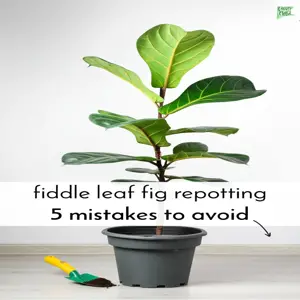
fiddle leaf fig care
- Root Rot: If you suspect root rot, carefully remove the plant from its pot and inspect the roots. Remove any dead or rotting roots with clean pruning shears. Repot the plant in fresh, well-draining soil. Consider using a fungicide to treat the remaining roots.
- Leaf Drop: Leaf drop can be caused by a variety of factors, including transplant shock, overwatering, underwatering, and changes in light or temperature. Identify the cause of the leaf drop and address it accordingly.
- Stunted Growth: Stunted growth can be caused by nutrient deficiencies, rootbound conditions, or improper watering. Make sure you’re providing the plant with the right nutrients, repotting it as needed, and watering it properly.
- Pest Infestations: Repotting can sometimes expose plants to pests. Regularly inspect your Fiddle Leaf Fig for signs of pests and treat them promptly. Common pests include spider mites, mealybugs, and scale.
Fiddle Leaf Fig Trends and Statistics (2024 Update)
The Fiddle Leaf Fig remains a popular houseplant in 2024, despite its reputation for being finicky. Here are some updated trends and statistics:
- Continued Popularity: The Fiddle Leaf Fig continues to be a highly sought-after houseplant, driven by its aesthetic appeal and its presence on social media platforms like Instagram and Pinterest.
- Increased Availability of Cultivars: More cultivars are becoming available, including dwarf varieties and those with different leaf shapes and colors.
- Growing Demand for Sustainable Practices: Consumers are increasingly interested in sustainable plant care practices, such as using organic fertilizers and choosing eco-friendly potting mixes like coco coir.
- Rise of Plant Subscription Boxes: Plant subscription boxes that include Fiddle Leaf Figs or related care products are gaining popularity.
- Focus on Indoor Air Quality: Studies continue to highlight the air-purifying benefits of houseplants, including Fiddle Leaf Figs, driving demand among health-conscious consumers.
Read More: Do Houseplants Like Coffee Grounds?
According to a recent survey by the National Garden Bureau, houseplants are now present in over 75% of American households, with Fiddle Leaf Figs being among the most popular choices for their aesthetic and air-purifying qualities. However, a significant percentage of Fiddle Leaf Fig owners (estimated at around 40%) report experiencing challenges in keeping their plants healthy, often related to improper watering or repotting techniques.
Regulations and Considerations
While repotting a Fiddle Leaf Fig is generally straightforward, there are a few regulations and considerations to keep in mind:

fiddle leaf fig problems
- Soil Disposal: In some areas, there may be regulations regarding the disposal of old potting soil. Check with your local waste management authority for guidelines.
- Pesticide Use: If you need to use pesticides to treat pests on your Fiddle Leaf Fig, be sure to follow the manufacturer’s instructions carefully and choose products that are safe for indoor use. Some municipalities have restrictions on certain types of pesticides.
- Import/Export Restrictions: If you’re moving your Fiddle Leaf Fig across state lines or internationally, there may be import/export restrictions to consider. Check with the relevant authorities before moving your plant.
- Invasive Species: Although Fiddle Leaf Figs are not typically considered invasive, it’s important to prevent them from escaping into natural environments. Properly dispose of any plant waste and avoid planting Fiddle Leaf Figs outdoors in areas where they are not native.
It’s always a good idea to research your local regulations regarding plant care and disposal to ensure you’re in compliance.
FAQ: Your Fiddle Leaf Fig Repotting Questions Answered
Here are some frequently asked questions about repotting Fiddle Leaf Figs:
How often should I repot my Fiddle Leaf Fig?
Typically, you should repot your Fiddle Leaf Fig every 1-2 years, or when you notice the signs mentioned earlier (roots emerging, slowed growth, etc.). Young plants may need repotting more frequently than mature plants.
Can I repot my Fiddle Leaf Fig at any time of year?
While it’s best to repot during the spring or early summer, you can repot at other times of the year if necessary. However, the plant may experience more stress during the dormant season (fall and winter).
What type of pot is best for a Fiddle Leaf Fig?
Terracotta pots are generally recommended, as they allow for better airflow and drainage. However, plastic pots can also be used, especially if you tend to underwater your plants. Make sure the pot has drainage holes.
Can I reuse old potting soil?
It’s generally not recommended to reuse old potting soil, as it may be depleted of nutrients and harbor harmful bacteria or fungi. However, if you must reuse it, you can sterilize it by baking it in the oven or microwaving it.
How much should I water my Fiddle Leaf Fig after repotting?
Water thoroughly until water drains out of the drainage holes. Then, allow the soil to dry out slightly before watering again. Check the soil moisture regularly.
Do I need to fertilize my Fiddle Leaf Fig immediately after repotting?
No, wait at least 4-6 weeks before fertilizing your Fiddle Leaf Fig. The fresh soil will already contain nutrients.
What if I accidentally damage the roots during repotting?
If you accidentally damage the roots, don’t panic. Remove any severely damaged roots with clean pruning shears. Repot the plant in fresh soil and provide extra humidity. Avoid overwatering.
How do I know if my Fiddle Leaf Fig is experiencing transplant shock?
Signs of transplant shock include wilting leaves, leaf drop, and slowed growth. Provide adequate humidity, avoid overwatering or underwatering, and protect the plant from direct sunlight.
Can I repot a Fiddle Leaf Fig that’s already stressed?
It’s generally best to address the underlying cause of the stress before repotting. However, if the plant is severely rootbound or the soil is in poor condition, repotting may be necessary. Be extra gentle and provide optimal care after repotting.
My Fiddle Leaf Fig is too big to repot easily. What should I do?
For very large Fiddle Leaf Figs, you can try surface repotting. This involves removing the top few inches of soil and replacing it with fresh soil. You can also carefully prune the roots to reduce the size of the root ball. Consider hiring a professional to help with the repotting process.
Read More: Diatomaceous Earth: Uses, Benefits & Safety Tips (2025)
Conclusion: Your Fiddle Leaf Fig Repotting Journey
Repotting your Fiddle Leaf Fig doesn’t have to be a source of stress. By understanding the common mistakes and following these pro tips, you can confidently give your plant the fresh start it needs to thrive. Remember, patience is key. Your Fiddle Leaf Fig may experience some transplant shock, but with proper care and attention, it will bounce back stronger than ever. This isn’t just about repotting; it’s about understanding your plant’s needs and creating an environment where it can flourish. With the right pot, the right soil, and the right post-repotting care, you’ll be well on your way to enjoying the beauty and elegance of your Fiddle Leaf Fig for years to come. Keep learning, keep observing your plant, and don’t be afraid to experiment to find what works best for your unique environment.
Happy repotting!
Auto Amazon Links: No products found.
Perfect Plants Christmas Tree Saver 8oz. | Easy Use Xmas Tree Preserver Food | Have Healthy Green Christmas Trees All Holiday Season
$7.99 (as of December 31, 2025 13:55 GMT +00:00 - More info- Product prices and availability are accurate as of the date/time indicated and are subject to change. Any price and availability information displayed on [relevant Amazon Site(s), as applicable] at the time of purchase will apply to the purchase of this product.
FirEver Pure Christmas Tree Food | Preserver Additive & Season Extender for Live Xmas Trees | Keep It Green, Reduce Needle-Drop | Miracle Freshness (8 oz)
$9.16 (as of December 31, 2025 13:55 GMT +00:00 - More info- Product prices and availability are accurate as of the date/time indicated and are subject to change. Any price and availability information displayed on [relevant Amazon Site(s), as applicable] at the time of purchase will apply to the purchase of this product.
VISTARAFT 47 Inch Long Christmas Tree Watering Funnel, Christmas Tree Watering System Device Long Tree Watering Waterer Spout for Indoor Outdoor Xmas Tree - Red
$8.99 (as of December 31, 2025 13:55 GMT +00:00 - More info- Product prices and availability are accurate as of the date/time indicated and are subject to change. Any price and availability information displayed on [relevant Amazon Site(s), as applicable] at the time of purchase will apply to the purchase of this product.
Wilt-Pruf® Christmas Tree/Cutting Preserver Spray |Preserves Christmas Trees, Wreaths, Garlands, Cuttings and Carved Pumpkins | Reduces Needle Drop | Keeps Cut Trees Fresh Longer | Natural (32 oz)
$21.99 (as of December 31, 2025 13:55 GMT +00:00 - More info- Product prices and availability are accurate as of the date/time indicated and are subject to change. Any price and availability information displayed on [relevant Amazon Site(s), as applicable] at the time of purchase will apply to the purchase of this product.
Rocky Mountain Goods Christmas Tree Food - 8 oz Tree Preservative - Reduce Needle Drop - Greener Scent - Fir, Pine, Spruce Trees - Extend Tree Life
$9.95 (as of December 31, 2025 13:55 GMT +00:00 - More info- Product prices and availability are accurate as of the date/time indicated and are subject to change. Any price and availability information displayed on [relevant Amazon Site(s), as applicable] at the time of purchase will apply to the purchase of this product.
Snow Joe Premium Enviro Blend Ice Melt, Green-Coated Deicer Crystals, 50 lb - Safer Melter for Vegetation, Concrete & Metals w/ Anti-Corrosion Calcium Magnesium Acetate
$32.97 (as of December 31, 2025 15:15 GMT +00:00 - More info- Product prices and availability are accurate as of the date/time indicated and are subject to change. Any price and availability information displayed on [relevant Amazon Site(s), as applicable] at the time of purchase will apply to the purchase of this product.
OLANLY Dog Door Mat for Muddy Paws 30x20, Absorbs Moisture and Dirt, Absorbent Non-Slip Washable Doormat, Quick Dry Chenille Mud Mat for Dogs, Entry Indoor Entryway Carpet for Inside Floor, Grey
$9.49 (as of December 31, 2025 15:15 GMT +00:00 - More info- Product prices and availability are accurate as of the date/time indicated and are subject to change. Any price and availability information displayed on [relevant Amazon Site(s), as applicable] at the time of purchase will apply to the purchase of this product.
TERRO Ant Killer Bait Stations T300B - Liquid Bait to Eliminate Ants - Bait System - 12 Count Stations for Effective Indoor Ant Control
$10.88 (as of December 31, 2025 15:15 GMT +00:00 - More info- Product prices and availability are accurate as of the date/time indicated and are subject to change. Any price and availability information displayed on [relevant Amazon Site(s), as applicable] at the time of purchase will apply to the purchase of this product.
Zevo Flying Insect Trap Official Refill Cartridges - Fits Both Zevo Trap & MAX Indoor Fly Trap - Authentic Trap+Lock Technology to Catch Gnats, House & Fruit Flys (4 Official Refill Cartridges)
$14.97 (as of December 31, 2025 15:15 GMT +00:00 - More info- Product prices and availability are accurate as of the date/time indicated and are subject to change. Any price and availability information displayed on [relevant Amazon Site(s), as applicable] at the time of purchase will apply to the purchase of this product.
Advion Cockroach Gel Bait, 4 Tubes x 30-Grams, 1 Plunger and 2 Tips, German Roach Insect Pest Control, Indoor and Outdoor Use, Roach Killer Gel for American, German and Other Major Cockroach Species
$25.94 (as of December 31, 2025 15:15 GMT +00:00 - More info- Product prices and availability are accurate as of the date/time indicated and are subject to change. Any price and availability information displayed on [relevant Amazon Site(s), as applicable] at the time of purchase will apply to the purchase of this product.

